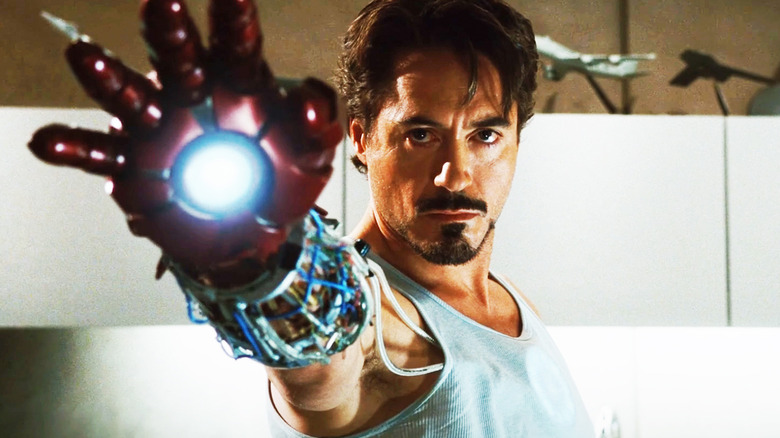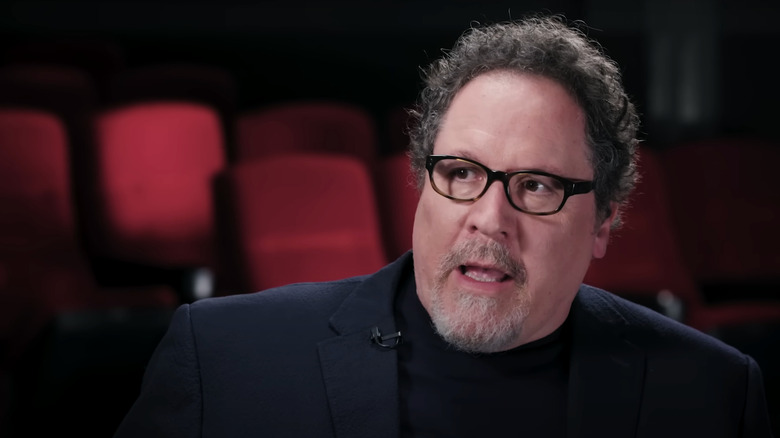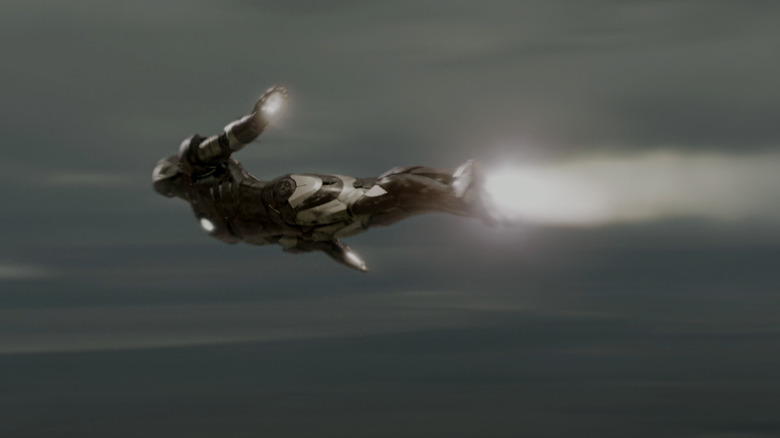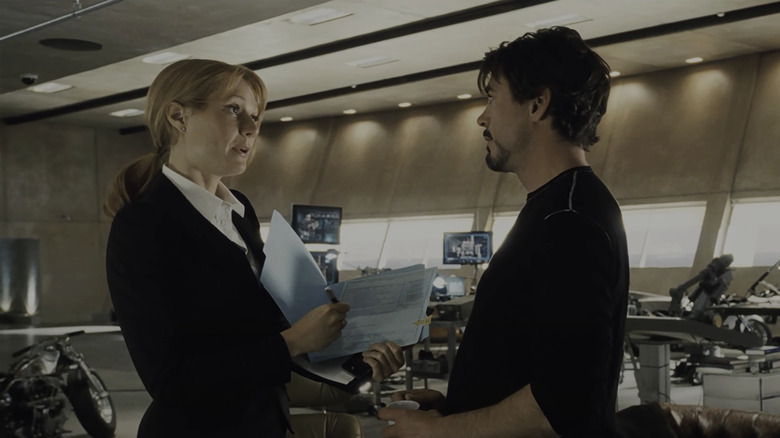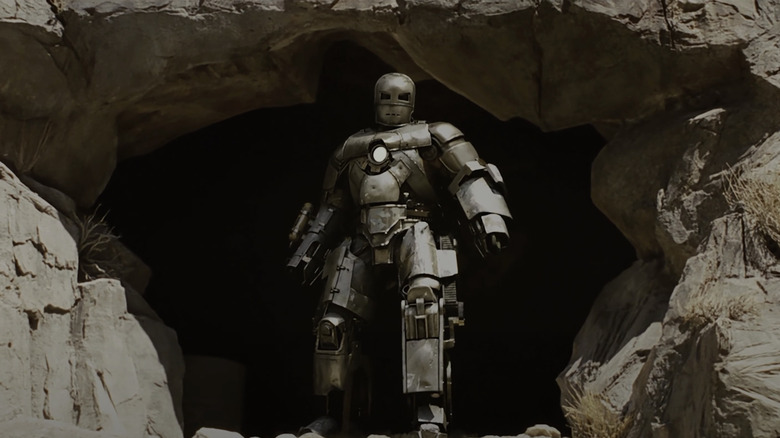The One Word That Guided Jon Favreau's Every Decision For Iron Man
Depending on how you feel in the age of way too much Marvel Cinematic Universe, 2008 was either the beginning of an important shift in cinema history or the cause of all our modern troubles. That's because it was the year the first MCU movie, "Iron Man," debuted and promptly changed Hollywood forever. Back then, Marvel Studios was an independent company on a mission to establish a shared on-screen universe that would turn its lesser-known heroes into the cultural icons they now are.
That mission kicked off with "Iron Man," which, thanks to some inspired casting that saw Robert Downey Jr. play Tony Stark/Iron Man (winning the role over Timothy Olyphant), proved to be a big hit. Downey was the perfect man for the job, bringing so much charisma to the part that it even radiated through that all-enveloping body armor. Downey's casting was arguably, as Marvel Studios head Kevin Feige put it, "One of the greatest decisions in the history of Hollywood."
But it wasn't just RDJ that helped make "Iron Man" so popular. In fact, there was an even more important element to the film's success: Director Jon Favreau. The man responsible for 2003's "Elf" and 2005's "Zathura: A Space Adventure" perhaps didn't seem like the obvious choice to help launch the most successful superhero franchise in cinema history. But then, Downey, with his troubled past and apparent lack of movie star credibility, also didn't seem like the ideal choice. Both of these guys, however, proved they knew exactly what they were doing, and in Favreau's case demonstrated a knack for the small, more character-focused moments that the modern MCU is sorely lacking. And for him, it all came down to a whiteboard hanging in his office.
The 'Elf' guy?
Jon Favreau is partly responsible for Robert Downey Jr. being cast in the first place, having used some sneaky tactics that involved leaking news of Downey's casting before it had been confirmed by the Marvel suits. But the director's influence went far beyond securing the right lead actor. As recounted in the book "MCU: The Reign of Marvel Studios," Marvel head Kevin Feige, who at the time was a comparatively lowly President of Production for the company, went after Favreau. Having propelled "Elf" to an impressive $224 million box office take on a $32 million budget, Favreau had courted attention for his directorial abilities. But Feige also wanted him for "Iron Man" because he recognized his talent for small-scale, character-focused filmmaking translating well to blockbusters. As Feige put it:
"Going back to my experience watching Sony and [Sony President] Laura Ziskin and Avi [Arad] hire Sam [Raimi], or Fox hire Bryan Singer, those were not people who had just come out with a big, giant blockbuster and now were doing their next. They were filmmakers who'd done super-interesting movies on a lesser scale coming into a bigger platform."
Then-Marvel Studios head David Maisel echoed that sentiment, praising Favreau's ability, "to make a scene around the kitchen table as interesting as a fight at the end of the movie." As it turned out, the director wasn't just adept at making these smaller moments as interesting as the action, he actually seemed to prefer the kitchen table scenes over the more bombastic ones. To that end, Favreau adopted a guiding principle that influenced his every move on the film — or rather, a single guiding word.
You'll believe a man can fly ... and shoot lasers and stuff
In "MCU: The Reign of Marvel Studios," the authors explain how Jon Favreau was drawn to Marvel Studio's then-independent status because it meant he would have much more freedom to bring his vision to life. That vision was driven by a commitment to believability. The book goes on to explain that on his first day at Marvel Studios, the filmmaker arrived at his "shabby" office and "wrote one word on a whiteboard: PLAUSIBILITY."
Much like Richard Donner, who exactly 30 years prior to "Iron Man" had made believability the guiding principle of his own superhero movie, 1978's "Superman," Favreau was adamant that "Iron Man" would be as grounded and as credible as possible. Within reason, of course — Tony Stark/Iron Man is a billionaire genius who creates an advanced suit of armor and flies around shooting lasers out of his hands, after all. But that didn't stop Favreau from insisting on "plausibility" at every turn. As recounted in "The Reign of Marvel Studios," "Hundreds of ideas about the film came and went on that whiteboard, but that one word, plausibility, always stayed."
'I'm going to be the character guy'
In 1978, Richard Donner made believability the cornerstone of his "Superman" movie. The tagline "You'll believe a man can fly" famously accompanied every poster tied to the film, and it was a line Donner took seriously enough that he went to great pains to make the flying scenes as realistic as possible. While he was making a film about a super-powered alien who saves Earth from a megalomaniacal super-villain, the underlying philosophy was always one of believability. That was why the director hung a sign in his office that showed the Man of Steel flying over the word "VERISIMILITUDE."
"Superman" was the first big superhero blockbuster, breaking records and paving the way for every comic book adaptation that followed. But it was arguably the film's smaller moments, the connections between characters, and its reverence for the source material that made it the enduring movie it is. Similarly, with "Iron Man," Jon Favreau was focused much more on character than action, reportedly handing off the latter to other members of the creative team. "Iron Man" concept artist Stephen Platt recalled in "The Reign of Marvel Studios," that Favreau told him:
"Look, I'm going to lean on you guys to really pump up and elevate the action, because I'm going to be focusing on character. I'm going to be the character guy, but when it comes to action, just turn it up to 11, and we'll see where it takes us. Then I'll be able to figure out from there how it's supposed to feel."
"Iron Man" built the foundation of the MCU not solely with flashy action sequences, but by balancing those sequences with characters who, despite the fantastical nature of the story they were in, felt real (some might say "plausible").
It wasn't just about the characters
With "Iron Man," we weren't exactly getting the grounded cinematic reality of Christopher Nolan's "The Dark Knight." Marvel Studios' inaugural film was guided more by compelling character interaction and cool tech than political allegory or complex plot. But that fealty to believability was there, and it applied to more than character moments. It also guided the way the Iron Man armor developed over multiple iterations before becoming the classic red and gold version we all know.
Speaking to SuperHeroHype, Favreau broke down his approach to the armor and how he built believability into that aspect of his film:
"When he builds the first suit, we tried to make it look like the Mark I Gray Armor, 'Tales of Suspense' #39, but we also wanted it to look like it actually could have been built out of the parts of his weapons that he had available to him [...] As he got into the Mark II we wanted that to feel more like an airplane prototype [...] Hopefully we took baby steps and developments that you could finally believe that when Iron Man steps onto the screen, you've watched it being designed and birthed and believe that the technology has evolved over the course of the film."
Favreau also elaborated on his "Plausibility" sign in that interview, which, according to him, was actually hung over his office door. The director explained his idea that "everybody who came in for a meeting would have to read that and remember that that was the tone of our film." Now, as Marvel struggles to maintain its success in the age in of streaming and superhero over-saturation, Kevin Feige and co. would do well to remember the tone of their first movie.
